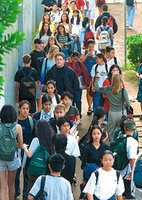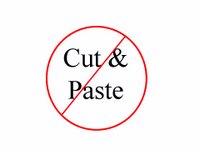
It is not your environment;
it is not your history;
It is not your education or ability.
It is the quality of your mind
that predicts your future.
- Dr. Benjamin MaysHappy New Year!
Tags: new year, holiday greetings, quotes, education by sistrunk
Join me in this unique forum to discuss pressing issues in technology, business, education, and current events. We'll explore topics of interest to all.

It is not your environment;
it is not your history;
It is not your education or ability.
It is the quality of your mind
that predicts your future.
- Dr. Benjamin MaysHappy New Year!
 Report examines impact of education law
Report examines impact of education lawThe center has been conducting an ongoing review of the law, gathering information, surveying education officials in all 50 states and producing numerous reports on various aspects of NCLB.
The law, which is up for reauthorization in 2007, is aimed at raising achievement and closing the achievement gap. It holds schools accountable for test scores, test participation, attendance and graduation rates for all students. To read the CEP report (a PDF document), click here.
 Efforts to boost graduation rates
Efforts to boost graduation ratesMissouri Commissioner of Education Names Special
Advisory Committee on St. Louis Public Schools
Commissioner of Education D. Kent King on Thursday appointed five Missourians to a special committee that will help find solutions to the continuing turmoil in the St. Louis Public Schools. King announced the appointments during a meeting of the State Board of Education in Jefferson City.
Since the abrupt resignation of the school district's superintendent two weeks ago, King said there have been calls for various types of intervention by state education officials in the operations of the school district.
"Under current law, we can consider various levels of intervention in the school district. However, I would like to give the new administration and the school board some breathing room so they can stabilize the district and prepare for the opening of school on August 28.
"I am grateful to these five citizens for their willingness to help the State Board of Education and the St. Louis Public Schools through this difficult time," King said. The following individuals have agreed to serve on the committee:
Dr. William H. Danforth, Chancellor Emeritus
Washington University, St. Louis
Mrs. Frankie M. Freeman, Attorney
Mr. Ned Lemkemeier, Attorney
Mr. Michael Middleton, Deputy Chancellor
University of Missouri-Columbia
Dr. Donald Suggs, Publisher
St. Louis American newspaper
Dr. Danforth and Mrs. Freeman will co-chair the committee. They currently serve as co-chairs of the St. Louis Community Monitoring and Support Task Force. Mr. Lemkemeier is a member of the task force. The task force was created by the federal court to oversee implementation of the January 1999 settlement agreement in the St. Louis desegregation case.
Commissioner King said he will ask the committee to gather information and make recommendations on the following topics:
Analyzing the district'’s academic performance and identifying steps the district must take to regain full accreditation.
Reviewing issues related to the desegregation settlement agreement, governance of the district, and the district'’s accreditation status.
Clarifying the financial condition of the school district.
Clarifying the primary concerns of parents and community residents about the governance and operations of the district.
Recommending potential changes in state law concerning the state'’s involvement with the school district.
"The district's accreditation status will be determined this fall by the State Board of Education, based largely on the academic performance of St. Louis students during 2005-06. I am not optimistic that we will see improved test scores this year," King said. The district is currently "provisionally accredited" under state standards.
"In the meantime, I hope this committee will help reduce tensions in the St. Louis community and help all parties restore their focus on the common goal of providing a safe and positive learning environment for children.
"We do not have a goal of taking over Missouri'’s largest school district. That is a drastic measure, and we would rather spend our energy on improving education for the students. The St. Louis board of education, however, must find a way to restore stable and effective leadership for the district. If it cannot do so, we will not hesitate to intervene on behalf of the students, parents and teachers," King said.
###

Today's parents work long hours, extra jobs and must handle a host of other responsibilities. Resources such as Parent Information Resource Centers (PIRCs) offer assistance in many states. Many community centers also provide help. By all means, do not overlook your child's school, which can provide a wealth of information.
Education starts at home. Kids spend most of their waking hours outside of school. Rose Jackson-Beavers, an author and director of parent services for the Parent Engagement and Empowerment Center in St. Louis, believes that even busy parents can take an active role in their child's education. According to Jackson-Beavers, the benefits of ongoing parent involvement are substantial.
"A parent's opportunity to get involved in their child's education doesn't end the moment that child walks into the classroom," said Jackson-Beavers. "Studies show that children with involved parents have more positive learning experiences. This translates into better academic performance, higher grades and test scores. I know our parents can make this happen with a little help."
Here are tips on how busy parents can work smart:
- Send your child to school well-fed and rested.
- Stay on top of homework.
- Attend open house or back-to-school night at your child's school. It's the perfect time to meet your child's teacher. If you have to work, schedule a meeting with the teacher at another time.
- Go to parent-teacher conferences.
- Each day, ask your children what they are learning at school. Discuss it with them or have them explain it.
- Set high expectations for your children. Encourage them to do their best.
- Get involved in your school's parent-teacher organization, and find out other ways you can support your child's school.
St. Louis parents offer their own advice on best practices. Kimberly Brandon is the mother of a middle school student. She also taught elementary school for 22 years in a suburban school district. Family friends notice that Brandon and her daughter, Margaret, always work together as a team. They even tackle homework at the hair salon!
"I learned right away to be the best teacher you could be for your child at home," said Brandon. "Don't ever stop working with your child. Anytime my daughter has homework, I am involved in it." Brandon emphasizes that the effort comes with rewards. Margaret now carries a 4.0 grade point average.
Another St. Louis mom, Leslie Smith, encourages parents to establish ongoing communication with their children. Kids will talk to me before they will talk to their mom or dad," Smith stated. "They are afraid to talk to their parents." Smith says it is important that parents listen to their kids.
Debbie Crump has the experience of being a mother, a grandmother, and a foster mom. She says that when she was raising her own children, her job made it difficult for her to be active in school.
Nevertheless, Crump emphasizes, "You definitely need to develop a relationship with the teacher. Let the teacher know that you really care about your child's education."
Crump, who is proud of her adult kids, now raises two foster children.
Bottom line: When parents are involved in their children's education, kids do better in school.
Additional Resources:
 Schools experiment with a new strategy
Schools experiment with a new strategy U.S. may be losing global edge, study suggests
U.S. may be losing global edge, study suggests Former trucker teaches surgery
Former trucker teaches surgery Strategies from a teacher
Strategies from a teacherRelationship building….that’s my mission. I think I already have some good pieces of the puzzle in place, however, I need to get over myself and call, call again, and call some more. Once I have my rosters in a few short weeks I need to call and introduce myself. I need to prepare some questions during my time off that well help me keep the conversation focused on their child and his or her needs as a student. What do you like best about your child? What is your child’s strengths? What discipline strategies do you follow at home? Who is at home when your child arrives? Who will be helping your child with his/her homework? I need to note previous low grades, previous low test scores, previous excessive absences or tardies and address them in a positive manner. I need to make myself available in this introductory phone call for questions the parent may have. Phone calls should continue through the first nine weeks and on into the year. Phone calls should not be made just when there is a problem. I believe that I could take my rosters and divide up the phone calling so that it would manageable for my busy schedule throughout each nine week period.
Another strategy to continue building and maintain good relationships all year long would be to continue with my weekly or bi-weekly newsletter. This could be sent home as before, but this time I could employ the students to help of papers and they might be more willing to get it home when they should. I also would like to send the newsletter by email when possible and make it available on line. I want to develop a classroom blog where parents could see daily updates on what we are doing the classroom as well as pictures that could be uploaded for viewing. Student work could be posted and my writers could have their works published.
I believe that I have here a good framework for cementing good relationships with parents. The key is communication. I am sure that I will still have a few parents balk at my overtures for a good relationship, but many more can be brought on board by a simple phone call. I am the teacher, and there really is no excuse not to pursue relationships.
 Nearly one-third of black students report serious disruptions and distractions
Nearly one-third of black students report serious disruptions and distractions30% of black students report that teachers spend more time trying to keep order than teaching
30% say their school has very serious problems with drug and alcohol abuse
32% report very serious problems with fighting and weapons
33% say their school is not consistent in enforcing discipline and behavior rules
37% say their school has a very serious problem with kids cutting class
52% say their school has a very serious problem with kids who lack respect for teachers and use bad language
Nearly half of Hispanic students (48%) report that their school has a very serious problem with kids dropping out.
 Examining the effectiveness of the federal mandate
Examining the effectiveness of the federal mandateMore than 23,000 schools, a quarter of all public schools, failed to meet their NCLB test targets this year. Growing numbers will face the now-familiar NCLB sanctions of student transfers and supplemental tutoring. Many schools also face penalties of "restructuring." That means state or private takeover, or other major reorganization.
Critics of NCLB cite lack of funding to meet mandates, vagueness in the 1100-page legislation and questions as to whether the law has actually fostered improved student achievement. Stan Karp examines the issues for Rethinking Schools magazine.
* * * * * * * * * * *
NCLB background
In 2002, President Bush signed into law the most sweeping educational reform law since the Elementary and Secondary Education Act was first enacted in 1965. Authors of the legislation say it is designed to improve student achievement and change the culture of America’s schools.
NCLB passed with bipartisan support. The statute addresses four principles of education reform:
- stronger accountability for results
- increased flexibility and local control
- expanded options for parents
- emphasis on teaching methods that are proven to work
There are five nationwide goals for all children:
- proficiency in reading and math by the 2013-2014 school year
- English proficiency for limited English proficient students
- qualified teachers in every classroom by 2005-2006
- safe and drug-free learning environments
- high school graduation for all students
Related: U.S. Department of Education, National Education Association
 Research addresses five challenges facing educators
Research addresses five challenges facing educators- Creating personalized and orderly learning environments
- Assisting students
- who enter high school with poor academic skills
- Improving instructional content and practice
- Preparing students for the world beyond high school
- Stimulating change in overstressed high schools
 In academic push, "quiet time" replaces classroom shut-eye
In academic push, "quiet time" replaces classroom shut-eye Online guide serves wide range of needs
Online guide serves wide range of needs New publication provides strategies for school counselors
New publication provides strategies for school counselors Paying for college: Resourcefulness the key
Paying for college: Resourcefulness the key 'Whatever It Takes'
'Whatever It Takes' Web journals become the new fly on the wall
Web journals become the new fly on the wall Program encourages collaboration between schools of different countries
Program encourages collaboration between schools of different countries Pop! goes the curriculum
Pop! goes the curriculumHigh School Dropouts: The Silent Epidemic
By George E. Curry
If you listen carefully, you still can’t hear it. It’s the sound of a third of high school students dropping out before receiving their diploma. For people of color, the figure is almost 50 percent and that has profound implications not only for the students, but for the society that failed them.
“The Silent Epidemic: Perspectives of High School Dropouts” is an important report on the dropout problem told from the viewpoints of true experts – the students themselves. The study, which focuses on polling and focus groups, is a joint project by the Civic Enterprises and Peter D. Hart Research Associates for the Bill & Melinda Gates Foundation.
In 2003, about 3.5 million youth 16 to 25 did not have a high school diploma and were not enrolled in school.
The report begins with “An Open Letter to the American People” that gets directly to the point: “There is a high school dropout epidemic in America. Each year, almost one third of all public high school students – and nearly one half of all blacks, Hispanics and Native Americans – fail to graduate from public high school with their class. Many of these students abandon school with less than two years to complete their high school education.”
And society has plenty of reasons to care.
“The decision to drop out is a dangerous one for the student,” the report continued. “Dropouts are much more likely than their peers who graduate to be unemployed, living in poverty, receiving public assistance, in prison, on death row, unhealthy, divorced and single parents with children who drop out from high school themselves.”
The report on this silent epidemic allows us to listen to what those who quit say about their predicament.
“The central message of this report is that while some students drop out because of significant academic challenges, most dropouts are students who could have, and believe they could have, succeeded in school,” the study said. “This survey of young people who left high school without graduating suggests that, despite career aspirations that require education beyond high school and a majority having grades of C or better, circumstances in students’ lives and an inadequate response to those circumstances from the schools led to dropping out.”
We tend to think of high school dropouts as being incapable of handling the academic workload and there is some evidence that supports that view. For example, 35 percent of those polled said “failing in school” was a major factor in the decision to drop out. And 32 percent had repeated a grade before dropping out.
Nearly half of the former students – 47 percent – quit not because of the academic challenge, but because they found classes uninteresting.
“These young people reported being bored and disengaged from high school,” the report said. “Almost as many (42 percent) spent time with people who were not interested in school. These were among the top reasons selected by those with high GPAs and by those who said they were motivated to work hard.”
An even larger number of students – 69 percent – said they were not motivated or inspired to work hard. In fact, two-thirds said they would have worked harder had it been required of them.
Naturally, there were other real life factors that caused some students to drop out. Approximately a third said they had to get a job and make more money, 26 percent said they became a parent and 22 percent said they had to care for a family member.
It became clear that the decision to quit school was not a spur of the moment choice. Rather, it was a culmination of growing disengagement and frequent absences from classes.
There was also a significant number of students who fell behind in the early years and never felt they caught up – or could catch up – with their classmates.
Among the recommendations made in the report:
- Provide a more supportive academic environment at school and at home that would improve the student’s chances of remaining in school
- Improve the teaching and curricular to make school more relevant and engaging
- Offering tutoring and summer school for struggling students
- Operate a more disciplined classroom
- Make sure that students have a strong relationship with at least one adult in the school
- Improve communication between parents and schools
And parents need to improve their communication with their children.
“The majority of parents were ‘not aware’ or just ‘somewhat aware’ of their child’s grades or that they were about to leave school,” the report said. “Nearly half of the respondents said their parents’ work schedule kept them from knowing more about what was happening at school and 68 percent said their parents got more involved when they became aware their child was on the verge of dropping out.”
Clearly, we all need to be more involved.
George E. Curry is editor-in-chief of the NNPA News Service and BlackPressUSA.com. To contact Curry or to book him for a speaking engagement, go to his Web site, www.georgecurry.com.
 Parent reveals 'Why I (still) send my kid to public school'
Parent reveals 'Why I (still) send my kid to public school' Probe to give fresh insights into the Red Planet
Probe to give fresh insights into the Red Planet Schools avoid class ranking, vexing colleges
Schools avoid class ranking, vexing colleges Directed 'Shaft' and 'The Learning Tree'
Directed 'Shaft' and 'The Learning Tree' Lessons learned after the disaster
Lessons learned after the disaster The growing problem of cheating
The growing problem of cheatingIt is a chronic problem that has been greatly facilitated by the resources-rich Internet.
This dangerous trend is not new, but advent of the Internet has facilitated the speed and methods used.